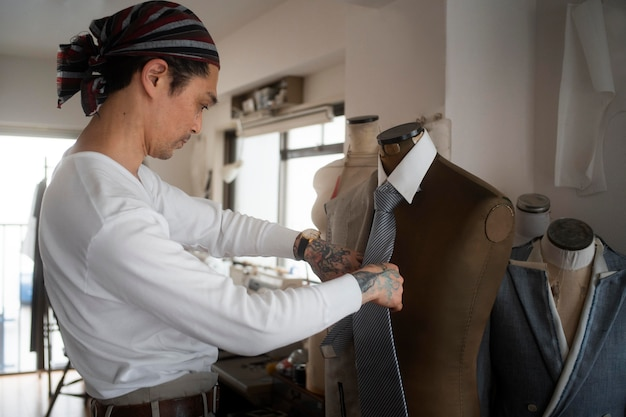
The fashion industry is at a crossroads. The global economic uncertainty and geopolitical factors have caused growth rates to slow, yet the demand for high-quality, sustainable, and personalized fashion continues to rise. Consumers are increasingly looking for products that not only meet their unique tastes but also align with their values.
As a custom clothing manufacturer, Kutetailor has witnessed these shifts firsthand. We see an undeniable growth in the global demand for high-quality, sustainable, and personalized products. Looking ahead to 2025, there are key areas of focus in production methods, technological innovation, supply chains, and design trends that will shape the future of the fashion manufacturing industry.
Sustainability is no longer a choice for fashion brands; it is a necessity. The push for eco-friendly materials and circular economy practices has accelerated. In response, manufacturers are embracing a range of sustainable practices that minimize environmental impact.
Recycled cotton, biodegradable nylon, and bio-based materials are becoming increasingly mainstream, along with many other eco-friendly materials. Besides saving waste, these materials conserve valuable natural resources. Many manufacturers now incorporate such sustainable materials into their processes in order to meet environmental and consumer needs.
The circular economy, which reduces waste through recycling and upcycling, is very important. For manufacturers, closed-loop systems in which garments are either produced from recycled materials or redesigned from existing ones avoid landfills of valuable resources. This approach enables zero-waste manufacturing and prolongs the life cycle of garments. More brands are partnering with manufacturers to make certain that their production lines support such sustainable goals.
Consumers, more than ever, are engaged in sustainability. They are demanding greater transparency in how products are made and are actively supporting brands that prioritize eco-friendly practices.

Apart from sustainability, there is an increasing demand for ethical labor practices. Since the tragic Rana Plaza incident, the fashion industry has been compelled to reassess working conditions in garment factories. Fair wages and safe working conditions are now being demanded by consumers and activists, while governments and organizations have promoted legislation to make sure that manufacturers comply with ethical standards.
Brands are increasingly required to be open about their supply chains, to show where and how the garments are made. Blockchain technology and digital tracking systems make it easy to share that information with the consumer, developing trust between the brand and the customer. Against this backdrop, brands permitting transparency in the manufacturing process will emerge as more capable of prospering in today's market.
The future of fashion manufacturing is all about technology. From AI to automation, 3D printing-the way clothes will be designed, made, and sold is changing.
AI is being utilized to predict fashion trends, optimize production, and improve overall efficiency. It helps designers create more accurate collections that match consumer demand while minimizing overproduction. This technology can also help optimize the supply chain, reducing waste and making production more cost-effective.
Automation in tasks like cutting, sewing, and packaging has enhanced efficiency and minimized errors. It has reduced labor costs and sped up production times. With 3D printing, manufacturers can rapidly prototype designs and offer personalized clothing options. This technology enables quick modifications to designs, leading to fewer resources being wasted on rejected samples.
Another significant trend is the feature of virtual trying and making it personalized. Individuals seek apparel with a personal touch, and many brands have taken this forward through dimensions, fabric types, and designs modified-all through digital platforms of course. These will enable businesses to fulfill the evolving demand for customized, tailor-made apparels.
The global fashion market is undergoing significant shifts. China's market is slowing down, but other Asian markets like Japan, Korea, and India are rising as new growth engines. (China is still in the lead, though.) In the U.S. and Europe, there are also shifts as high-net-worth individuals and the silver generation (50+ consumers) increase their fashion spend.
The e-commerce market is highly competitive, and brands are seeking ways to differentiate themselves through better customer experience, both online and offline. Retailers are adapting by blending digital channels with traditional in-store experiences to enhance customer engagement.
There is also a growing price sensitivity among consumers. While luxury brands continue to thrive, there is a growing trend toward discounts and resale markets. Brands must carefully navigate price points, communicating value to consumers and making sure they offer premium products for the right price.

· Maximalism: Bold prints, layered textures, and oversized accessories encourage consumers to embrace creativity and individual expression.
· Feminine Silhouettes: Soft, flowing dresses, lace, and romantic details offer an elegant and graceful aesthetic.
· Suede: Luxurious, versatile fabrics for skirts, jackets, and accessories.
· Matching Sets: Coordinated outfits for a polished look.
· 70s Revival: Retro-inspired fashion, including paisley prints, flared jeans, and fringe jackets.
· Sheer Fabrics: Lightweight, ethereal garments for warmer months.
· Military-Inspired Fashion: Structured, practical garments with a stylish edge.
· Asymmetry: Unique, off-balance cuts for an avant-garde look.
· Prints: Psychedelic, florals, animal prints, and geometric patterns.
· Color Trends: Pastels, neon hues, earth tones, jewel tones, and classic black-and-white.
· Sustainability and Circular Economy: Focus on reducing waste and improving recycling processes.
· Ethical Labor Practices and Transparency: Ensuring fair wages and ethical working conditions.
· AI, Automation, and Data Use: Improving production efficiency and minimizing waste.
· Local and Small-Batch Production: Reducing carbon footprints and increasing customization.
At Kutetailor, we are at the forefront of sustainable fashion manufacturing, offering fashion brands and businesses a one-stop Made-to-Measure (MTM) platform for creating tailor-made suits and apparel. Our commitment to sustainability drives us to prioritize transparent supply chains, ensuring that every garment we produce meets rigorous environmental standards without compromising on quality.
Our cutting-edge factory is among the pioneers in smart garment manufacturing, combining advanced technologies with traditional tailoring expertise. Through our full-customization approach, we enable brands to offer their customers the ability to self-design garments, ensuring that each piece is crafted to their exact specifications. The incorporation of intelligent tailoring and automated production processes allows us to produce high-quality, bespoke garments with swift delivery—typically within 7-10 days.
As part of our sustainable growth efforts, we have adopted practices that not only enhance efficiency but also contribute to a greener future. From the careful selection of durable fabrics to minimizing waste through automated processes, we are committed to creating fashion that’s both stylish and responsible.
The fashion industry is at an edge of a new wave, driven by sustainability, technological innovation, and personalization. As a visionary custom clothing manufacturer, Kutetailor is proud to offer global brands the opportunity to create high-quality, sustainable garments tailored to their consumers' most particular needs. We invite brands from the world over to join hands with us in embracing the future of fashion, where ethics and innovation go hand in hand.
The fashion industry in 2025 is expected to focus on sustainability, technology, and personalization. We’ll see more use of eco-friendly materials and recycled fabrics, with AI and automation streamlining production. Brands will also offer more customized clothing to meet consumer demands for unique, tailored products.
The future of the clothing industry will be driven by sustainable practices, technology, and personalization. We can expect to see more custom-made fashion, ethical production, and digital innovations like virtual try-ons and 3D printing. Consumers will continue to push for transparency in sourcing and manufacturing.
Brands can stay competitive by adopting new technologies, offering customization, and ensuring sustainable and ethical practices. Transparency in sourcing and quick, personalized service will also help brands build consumer trust.